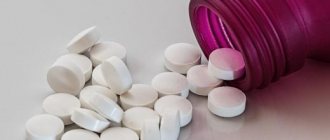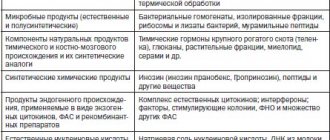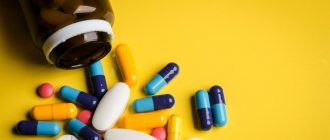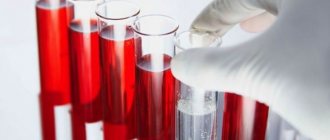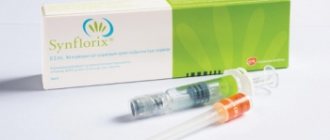Surfactant-BL (Surfaktant-BL)
Surfactant-BL is a highly purified natural surfactant from the lungs of cattle, is a complex of substances from a mixture of phospholipids and surfactant-associated proteins, has the ability to reduce surface tension on the surface of the pulmonary alveoli, preventing their collapse and the development of atelectasis.
Surfactant-BL restores the content of phospholipids on the surface of the alveolar epithelium, stimulates the involvement of additional areas of the pulmonary parenchyma in breathing and promotes the removal of toxic substances and infectious agents from the alveolar space along with sputum.
The drug increases the activity of alveolar macrophages and inhibits the expression and excretion of cytokines by polymorphonuclear leukocytes and eosinophils; it improves mucociliary clearance and stimulates the synthesis of endogenous surfactant by type II alveolocytes, and also protects the alveolar epithelium from damage by chemical and physical agents, and restores the functions of local innate and adaptive immunity.
The drug, when administered daily inhalation to experimental animals for 10 days, has no effect on the cardiovascular system, does not have a local irritating effect, does not affect blood composition and hematopoiesis, with the exception of short-term (1 day after stopping administration of the drug in doses of 200 and 400 mg/kg ) lymphopenia and granulocytosis due to an increase in the number of rod and segmented neutrophils. Subsequently, the composition of peripheral blood is completely normalized.
The drug does not affect the biochemical parameters of blood, urine and the blood coagulation system, does not cause pathological changes in the functions and structure of internal organs, and does not have teratogenic, allergenic and mutagenic properties.
After inhalation administration of the drug to rats 5 times a week for 6 months at total doses of 260 mg/kg, 520 mg/kg and 780 mg/kg and additional observation for another month without drug administration, no pathological changes were found in the morphology of the cardiovascular system. , central nervous and hematopoietic systems.
Multicenter randomized clinical trials were conducted in patients who received standard treatment with anti-tuberculosis drugs for 2-6 months before starting surfactant therapy and did not show positive dynamics.
Evaluation of the effectiveness of a two-month course of Surfactant-BL inhalations in the complex treatment of pulmonary tuberculosis showed the following: cessation of bacterial excretion after completion of the Surfactant-BL course was observed in 50% of patients and in 24.0% of patients in the control group. 16 weeks after the start of treatment, 80.0% of patients achieved abacillation compared to 62.0% of the control group; in 100% of patients in the main group and in 68.0% of patients in the control group, a decrease in infiltrative and focal changes was detected; In 70.0% of patients in the main group and in 36.0% of patients in the comparison group, closure of the cavity(s) was detected.
Thus, the effect of such combination therapy occurs much faster and in a significantly larger percentage of patients in comparison with accepted anti-tuberculosis therapy regimens.
Surfactant-BL instructions for use
Dosage form lyophilisate for preparation. emulsions for endotracheal, endobronchial and inhalation administration 75 mg: vial. 2 or 10 pcs. Release form, composition and packaging Lyophilisate for the preparation of an emulsion for endotracheal, endobronchial and inhalation administration in the form of a mass or powder pressed into a tablet, white or white with a yellowish tint, a prepared emulsion of white with a creamy and white with a yellowish tint, homogeneous, in which flakes or solid particles should be observed. 1 fl. — surfactant 75 mg 75 mg — Glass bottles with a capacity of 10 ml (2) — cardboard packs (5) — cardboard boxes.
Clinical and pharmacological group: Drug for the treatment of respiratory distress syndrome in newborns
Pharmacotherapeutic group: Surfactant
Indications : respiratory distress syndrome (RDS) in newborns weighing more than 800 g at birth; — in the complex treatment of acute lung injury syndrome (ALI) and acute respiratory distress syndrome (ARDS) in adults that developed as a result of direct or indirect lung damage; — in complex therapy of pulmonary tuberculosis, both in newly diagnosed patients and in case of relapse of the disease, in infiltrative (with and without decay) or cavernous clinical form, including in the presence of drug resistance of Mycobacterium tuberculosis, up to multidrug resistance.
Dosage regimen 1. Treatment of respiratory distress syndrome (RDS) in newborns. Before starting treatment, it is necessary to correct acidosis, arterial hypotension, anemia, hypoglycemia and hypothermia. Radiological confirmation of RDS is desirable. The drug is administered micro-jet, in the form of an aerosol through a nebulizer or bolus. With microjet administration, the surfactant-BL emulsion is administered slowly using a syringe dispenser (a dose of 75 mg in a volume of 2.5 ml) over 30 minutes, and in the form of an aerosol through an alveolar nebulizer - the same dose over 60 minutes. Surfactant-BL can be administered as a bolus at a dose of 50 mg/kg body weight (in a volume of 1.7 ml/kg). The second and, if necessary, third time, the drug is administered after 8-12 hours in the same doses, if the child continues to need an increased concentration of oxygen in the supplied gas mixture (FiO2>0.4). It should be remembered that repeated administrations of surfactant-BL are less effective if the first administration was delayed (late). In the case of severe RDS (type 2 RDS, which often develops in full-term infants due to meconium aspiration, intrauterine pneumonia, sepsis), it is necessary to use a large dose of surfactant-BL - 100 mg/kg. The drug is also re-administered at intervals of 8-12 hours, and, if necessary, for several days. An important factor in the effectiveness of the use of surfactant-BL in the complex treatment of RDS in newborns is the early start of surfactant-BL therapy, within two hours after birth if the diagnosis of RDS is established, but no later than the first day after birth. The use of high-frequency oscillatory ventilation significantly increases the effectiveness of surfactant-BL therapy and reduces the incidence of adverse reactions. Preparation of the emulsion: Immediately before administration of surfactant-BL (75 mg in a bottle), dilute 2.5 ml of 0.9% sodium chloride solution for injection. To do this, add 2.5 ml of warm (37°C) 0.9% sodium chloride solution into the bottle and let the bottle stand for 2-3 minutes, then carefully mix the suspension in the bottle without shaking, draw the emulsion into a syringe with a thin needle, pour it back into the bottle along the wall several (4-5) times until completely uniform emulsification, avoiding the formation of foam. The bottle must not be shaken. After dilution, a milky emulsion is formed; there should be no flakes or solid particles in it. Administration of the drug. Microjet injection. The child is first intubated and sputum is aspirated from the airway and endotracheal tube (ET). The correct location and correspondence of the size of the ET to the diameter of the trachea is important, since with a large leakage of the emulsion past the ET (more than 25% on a respiratory monitor or auscultation), as well as with selective intubation into the right bronchus or a high standing ET, the effectiveness of surfactant-BL therapy is significantly decreases or depreciates. Next, the respiratory cycle of the newborn is synchronized with the operating mode of the ventilator, using sedatives - sodium hydroxybutyrate or diazepam, and in cases of severe hypoxia - narcotic analgesics. The prepared surfactant-BL emulsion is administered through a catheter inserted through an adapter with an additional side entrance into the ET so that the lower end of the catheter does not reach the lower edge of the endotracheal tube by 0.5 cm. Administration is carried out using a syringe dispenser for 30 minutes, without interrupting mechanical ventilation, without depressurization of the breathing circuit. To distribute the surfactant evenly throughout the various parts of the lungs during drug administration, if the severity of the child’s condition allows, the first half of the dose is administered with the child positioned on the left side, and the second half of the dose with the child positioned on the right side. At the end of the administration, 0.5 ml of 0.9% sodium chloride solution is drawn into the syringe and the administration is continued to displace the remaining drug from the catheter. It is advisable not to carry out sanitation of the trachea for 2-3 hours after the administration of surfactant-BL. Aerosol administration of surfactant-BL is carried out using an alveolar nebulizer included in the circuit of a ventilator synchronized with inhalation, as close as possible to the endotracheal tube to reduce drug losses. If this is not possible, it is preferable to use a micro-jet or bolus route of administration. Ultrasonic nebulizers cannot be used to obtain an aerosol and administer the drug, since surfactant-BL is destroyed when the emulsion is treated with ultrasound. It is necessary to use compressor-type nebulizers. Bolus administration of surfactant-BL. Before administering the drug, as with microjet administration, stabilization of central hemodynamics, correction of hypoglycemia, hypothermia and metabolic acidosis are carried out. Radiological confirmation of RDS is desirable. The child is intubated and sputum from the respiratory tract and ET are aspirated. Immediately before the administration of surfactant-BL, the child can be temporarily transferred to manual ventilation using a self-expanding Ambu-type bag. If necessary, the child is sedated with sodium hydroxybutyrate or diazepam. The prepared surfactant-BL emulsion (30 mg/ml) is used at a dose of 50 mg/kg in a volume of 1.7 ml/kg. For example, a child weighing 1500 g is administered 75 mg (50 mg/kg) in a volume of 2.5 ml. The drug is administered as a bolus over 1-2 minutes through a catheter placed in the endotracheal tube, while the child is carefully turned on the left side and the first half of the dose is administered, then turned on the right side and the second half of the dose is administered. The introduction is completed with forced manual ventilation for 1-2 minutes with a concentration of inhaled oxygen equal to the initial value on the ventilator or manual ventilation using a self-expanding Ambu-type bag. Monitoring the saturation of hemoglobin with oxygen is mandatory; monitoring the content of blood gases before and after the administration of surfactant-BL is desirable. Next, the child is transferred to assisted ventilation or forced mechanical ventilation and the ventilation parameters are adjusted. Bolus administration of the drug allows you to quickly deliver a therapeutic dose into the alveolar space and avoid the inconvenience and adverse reactions of microjet administration. For full-term newborns weighing more than 2.5 kg with a severe form of type 2 RDS, due to the large volume of the emulsion, half the dose is administered as a bolus, and the other half of the dose as a micro-jet. Bolus administration can also be used for prophylactic administration of surfactant-BL. Subsequently, depending on the initial condition and the effectiveness of therapy, the child can be extubated with a possible transfer to a non-invasive method of ventilation with the maintenance of continuous positive airway pressure (CP AR). 2. Treatment of acute lung injury syndrome and acute respiratory distress syndrome in adults. Treatment with surfactant-BL is carried out by endobronchial bolus administration using a fiberoptic bronchoscope. The drug is administered at a dose of 12 mg/kg/day. The dose is divided into two injections of 6 mg/kg every 12-16 hours. Repeated administration of the drug (4-6 injections) may be required until there is a sustained improvement in gas exchange (an increase in the oxygenation index of more than 300 mmHg) and an increase in the airiness of the lungs on chest x-ray and the possibility of performing mechanical ventilation with FiO2 < 0.4. In most cases, the duration of the course of using surfactant-BL does not exceed two days. In 10-20% of patients, the use of the drug is not accompanied by normalization of gas exchange, primarily in those patients to whom the drug is administered against the background of advanced multiple organ failure (MOF). If there is no improvement in oxygenation within two days, the administration of the drug is stopped. The most important factor in the effectiveness of the use of surfactant-BL in the complex treatment of SOPL/ARDS is the time of initiation of drug administration. It must be started within the first 24 hours (preferably the first hours) from the moment the oxygenation index drops below 250 mmHg. The drug can also be administered prophylactically when there is a threat of developing SOPL/ARDS in patients with chronic lung diseases, including chronic obstructive pulmonary disease (COPD), as well as before extensive chest surgery at a dose of 6 mg/kg per day, 3 mg/day kg after 12 hours. Preparation of the emulsion. Before administration, surfactant-BL (75 mg in a bottle) is diluted in the same way as for newborns in 2.5 ml of 0.9% sodium chloride solution. The resulting emulsion, which should not contain flakes or solid particles, is diluted with an additional 0.9% sodium chloride solution to 5 ml (15 mg per 1 ml). Endobronchial administration is the optimal method of drug delivery. The administration of surfactant-BL is preceded by a thorough sanitation bronchoscopy, carried out according to standard techniques. At the end of this procedure, an equal amount of the drug emulsion is injected into each lung. The best effect is achieved by introducing the emulsion into each segmental bronchus. The volume of the injected emulsion is determined by the dose of the drug. The most effective way to use surfactant-BL in the treatment of SOPL/ARDS is a combination of endobronchial administration of the drug and a lung “opening” maneuver, and segment-by-segment administration of the drug is carried out immediately before the lung “opening” maneuver. After administration of the drug, for 2-3 hours it is necessary to refrain from sanitation of the bronchi and not to use drugs that increase sputum secretion. The use of intratracheal instillation is indicated if bronchoscopy is impossible. The emulsion is prepared according to the method described above. Before administering the drug, it is necessary to thoroughly sanitize the tracheobronchial tree, having previously taken measures to improve sputum drainage (vibromassage, postural therapy). The emulsion is injected through a catheter installed into the endotracheal tube so that the end of the catheter is located below the opening of the endotracheal tube, but always above the carina of the trachea. The emulsion must be administered in two doses, dividing the dose in half, with an interval of 10 minutes. In this case, also after instillation, a lung “opening” maneuver can be performed. 3. Treatment of pulmonary tuberculosis. Treatment of pulmonary tuberculosis is carried out by repeated inhalations of the drug surfactant-BL as part of complex therapy against the background of fully developed therapy with anti-tuberculosis drugs (ATD), that is, when the patient is empirically or on the basis of data on the drug sensitivity of the pathogen, 4- 6 antihypertensive drugs that are well tolerated by patients in the prescribed dose and combination. Only then is the patient prescribed surfactant-BL emulsion in inhalation at a dose of 25 mg per administration: - the first 2 weeks - 5 times a week; - the next 6 weeks - 3 times a week (every 1-2 days). The duration of the course is 8 weeks - 28 inhalations, the total dose of surfactant-BL is 700 mg. During the course of treatment with surfactant-BL, anti-tuberculosis drugs can be discontinued (replaced) according to indications. Chemotherapy continues after completion of the course of treatment with surfactant-BL. Preparation of the emulsion: before use, surfactant-BL (75 mg in a bottle) is diluted in the same way as for newborns in 2.5 ml of 0.9% sodium chloride solution. The resulting emulsion, which should not contain flakes or solid particles, is diluted with an additional 0.9% sodium chloride solution to 6 ml (12.5 mg per 1 ml). Next, 2.0 ml of the resulting emulsion is transferred to the nebulizer chamber and another 3.0 ml of 0.9% sodium chloride solution is added to it, stirring carefully. Thus, the nebulizer chamber contains 25 mg of surfactant-BL in 5.0 ml of emulsion. This is the dose for one inhalation to one patient. Thus, 1 bottle of surfactant-BL contains three doses for inhalation in three patients. The emulsion prepared for inhalation must be used within 12 hours when stored at a temperature of +4°C - +8°C (do not freeze the emulsion). Before use, the emulsion must be carefully mixed and warmed to 36°C-37°C. Inhalation administration: 5.0 ml of the resulting emulsion (25 mg) located in the nebulizer chamber is used for inhalation. Inhalations are carried out 1.5-2 hours before or 1.5-2 hours after meals. For inhalations, compressor-type inhalers are used, for example “Boreal”, Italy or “Pari Boy SX” from Pari GmbH, Germany or their analogues, which allow spraying small volumes of drugs and are equipped with an economizer device that allows you to stop the supply of the drug during exhalation, which is essential reduces drug losses. The use of an economizer is extremely important so that the patient receives a therapeutic dose of the drug without loss (25 mg). If, due to the severity of the condition, the patient cannot use the entire volume of the emulsion, breaks should be taken for 15-20 minutes and then continue inhalation. If there is a large amount of sputum, you should cough it up thoroughly before inhalation. If there is evidence of bronchial obstruction, 30 minutes before inhalation of the surfactant-BL emulsion, it is necessary to first inhale a beta2-adrenergic agonist (at the doctor's choice) that reduces bronchial obstruction. It is necessary to use only compressor and not ultrasonic nebulizers, since surfactant-BL is destroyed when the emulsion is treated with ultrasound. Before administering the drug, it is necessary to carry out a thorough sanitation of the tracheobronchial tree, having previously taken measures to improve sputum drainage: vibration massage, postural therapy and mucolytics, which must be prescribed 3-5 days before the start of surfactant-BL therapy in the absence of contraindications to their use.
Side effect 1. For respiratory distress syndrome (RDS) in newborns: With microjet and bolus administration of surfactant-BL, obstruction with the ET drug or regurgitation of the emulsion may occur. This can occur if the section of the instructions “preparation of the emulsion” is not followed (use of 0.9% sodium chloride solution with a temperature below 37°C, non-uniform emulsion), with a rigid chest, high activity of the child, accompanied by coughing, crying, discrepancy between the size of the ET and the internal diameter of the trachea, selective intubation, administration of surfactant-BL into one bronchus, or a combination of these factors. If all these factors are excluded or eliminated, then in this case it is necessary to briefly increase the peak inspiratory pressure (Ppeak) for a child on mechanical ventilation. If a child shows signs of airway obstruction when he is not on mechanical breathing, it is necessary to perform several respiratory cycles using manual ventilation with increased pressure to move the drug deeper. When using the aerosol method of administering the drug, such phenomena are not observed. Physical and instrumental monitoring of hemodynamics and hemoglobin oxygen saturation (SaO2) is mandatory. Bleeding in the lungs may occur, usually within 1-2 days after administration of the drug in premature infants with low or extremely low birth weight. Prevention of pulmonary hemorrhage consists of early diagnosis and adequate treatment of a functioning ductus arteriosus. With a rapid and significant increase in the partial oxygen tension in the blood, retinopathy can develop. The oxygen concentration in the inhaled mixture should be reduced as quickly as possible to a safe value, maintaining the target hemoglobin oxygen saturation within 86-93%. Some newborns experience short-term hyperemia of the skin, requiring assessment of the adequacy of mechanical ventilation parameters to exclude hypoventilation due to transient airway obstruction. In the first minutes after microjet and bolus administration of surfactant-BL, large bubble rales may be heard in the lungs during inspiration. For 2-3 hours after using surfactant-BL, you should refrain from sanitation of the bronchi. In children with intrapartum respiratory tract infection, administration of the drug may increase sputum production due to activation of mucociliary clearance, which may require their sanitation at an earlier date. 2. For ARDS and NOPS in adults: To date, no specific adverse reactions have been observed during the treatment of NOPS and ARDS of various origins with surfactant-BL. If the endobronchial route of administration is used, a deterioration in gas exchange lasting from 10 to 60 minutes is possible, associated with the bronchoscopy procedure itself. When arterial blood hemoglobin saturation with oxygen (SaO2) decreases below 90%, it is necessary to temporarily increase positive end-expiratory pressure (PEEP) and the oxygen concentration in the gas mixture supplied to the patient (FiO2). In the case of a combination of endobronchial administration of surfactant-BL and the maneuver of “opening” the lungs, no deterioration in gas exchange was observed. 3. For pulmonary tuberculosis: When treating pulmonary tuberculosis, in 60-70% of patients after 3-5 inhalations there is a significant increase in the volume of sputum discharge or sputum appears that was not there before the start of inhalations. Also, the intensity and pain of coughing is significantly reduced, and exercise tolerance is improved. These objective changes and subjective sensations are a manifestation of the direct action of surfactant-BL and are not adverse reactions.
Contraindications for use In respiratory distress syndrome (RDS) of newborns: - intraventricular hemorrhages of III-IV degrees; - air leak syndrome (pneumothorax, pneumomediastinum, interstitial emphysema); - developmental defects incompatible with life; — DIC syndrome with symptoms of pulmonary hemorrhage; With ARDS and SOPL in adults: - gas exchange disorders associated with left ventricular heart failure; - gas exchange disorders caused by broncho-obstruction; - children under 18 years of age, since clinical trials in this age group have not been conducted and doses have not been determined; - air leak syndrome. With pulmonary tuberculosis: - tendency to hemoptysis and pulmonary bleeding; - children under 18 years of age, since clinical trials in this age group have not been conducted and doses have not been determined; - air leak syndrome.
Use during pregnancy and breastfeeding Used for health reasons in the treatment of ARDS.
Use in children The drug is used for the treatment of respiratory distress syndrome (RDS) in newborns with a birth weight of more than 800 g. Contraindicated in: - intraventricular hemorrhages of III-IV degrees; — air leak syndrome (pneumothorax, pneumomediastinum, interstitial emphysema); - developmental defects incompatible with life; — DIC syndrome with symptoms of pulmonary hemorrhage; Contraindicated in children under 18 years of age for the treatment of ARDS, SOPL and pulmonary tuberculosis, since clinical trials have not been conducted in this age group and doses have not been determined.
Special instructions The use of surfactant-BL for the treatment of critical conditions of newborns and adults is possible only in a specialized intensive care unit, and for the treatment of pulmonary tuberculosis - in a hospital and a specialized anti-tuberculosis dispensary. 1. Treatment of respiratory distress syndrome (RDS) in newborns. Before administering surfactant-BL, mandatory stabilization of central hemodynamics and correction of metabolic acidosis, hypoglycemia and hypothermia, which negatively affect the effectiveness of the drug, are necessary. Radiological confirmation of RDS is desirable. 2. Treatment of nozzle and ARDS. The drug should be used as part of a comprehensive treatment of nozzle and ARDS, including rational respiratory support, antibiotic therapy, maintaining adequate hemodynamics and water-electrolyte balance. The question of the use of surfactant-BL for POPL combined with severe multiple organ failure (MOF) should be decided individually, depending on the possibility of correcting other components of MOF. Immediately after the administration of surfactant-BL, it is recommended to perform a maneuver of “opening” the lungs, and if this is impossible due to the patient’s condition, then performing a single inflation of the lungs with double the tidal volume. 3. Treatment of pulmonary tuberculosis. In rare cases, after 2-3 inhalations, hemoptysis may occur. In this case, it is necessary to interrupt the course of treatment with surfactant-BL and continue it after 3-5 days. Surfactant-BL has not been observed to be incompatible with any anti-tuberculosis drug. There are no data on interactions with anti-tuberculosis drugs administered in aerosols, so this combination should be avoided.
Effect on the ability to drive vehicles and operate machinery Treatment with surfactant-BL does not affect the ability to drive vehicles.
An overdose of Surfactant-BL with intravenous, intraperitoneal and subcutaneous administration to mice at a dose of 600 mg/kg and with inhalation administration to rats at a dose of 400 mg/kg does not cause changes in the behavior and condition of the animals. In no case was there any death of animals. During clinical use, no cases of overdose were observed.
Drug interactions Surfactant-BL cannot be used in conjunction with expectorants, since the latter will remove the administered drug along with sputum.
Storage conditions and periods : Protected from light, at a temperature not exceeding minus 5°C. Keep out of the reach of children. Shelf life: 1 year.
Conditions for dispensing from pharmacies By doctor's prescription. Used in hospital settings.

